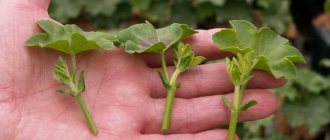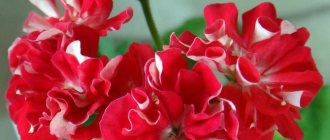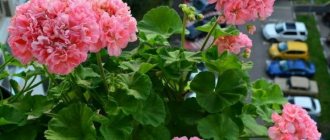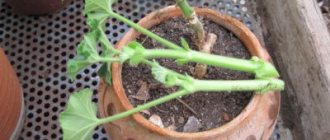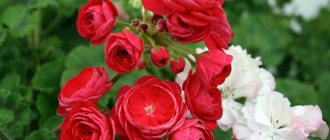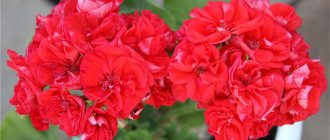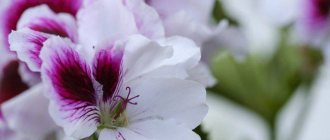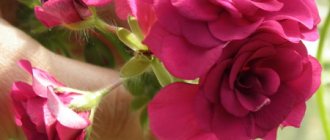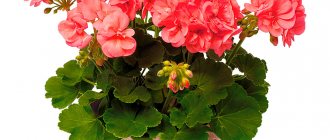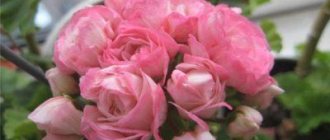Pelargonium PAC Viva - what kind of flower is it
Not everyone knows, but the entire genus Pelargonium belongs to the Geraniaceae family. Perhaps this is why ordinary people often confuse the varieties of these two plants; pelargonium is often called geranium and vice versa.
Pelargonium has excellent decorative properties
The plant, named PAC Viva, is a perennial subshrub that has creeping branches and fleshy foliage. The flowers are on long and powerful peduncles and can have different colors.
Brief description, history of origin or selection
This variety of pelargonium was bred by Swedish breeders. They showed their creation at a European exhibition. The first flower caused a real stir there.
A characteristic feature of the culture is the similarity of its flowers to rose buds. The petals have a terry structure. There may be 6-30 inflorescences on one umbrella. Each flower reaches 5 cm in diameter.
For reference! According to the description, the key advantage of the pelargonium variety PAC Viva is its long flowering.
The plant is compact in size. Its branches fit tightly to each other. The foliage has a hard and rough texture and is dark green in color.
Varieties of indoor plants with names and what they look like
Breeders have developed a whole group of varieties of this pelargonium. Each of them has certain advantages.
PAC Viva Madeleine
Pelargonium SOUTH Shukar, Aksinya, Ireland and other varieties
This plant variety is considered the most compact. Pelargonium Viva Madelina is characterized by dark green leaves. The shrub has neat outlines.
Flowering is typical. Pelargonium Madeline is characterized by white inflorescences with a slight pink color.
PAC Viva Carolina
The plant has large buds. They are characterized by a combination of white and lilac shades. The inflorescences have a fleecy texture. Each umbrella contains 5-6 flowers. The leaves are characterized by a typical bright green color.
PAC Viva Rosita
This culture is characterized by deep pink or coral petals. Geranium foliage has a lighter shade. A distinctive feature of the culture is considered to be lush and abundant flowering. Each inflorescence contains 5-7 buds. When they bloom, the culture looks truly luxurious.
PAC Viva Maria
A distinctive feature of the plant is the unusual color of the buds. It is characterized by a combination of white and pink tones. The white color is at the base of the petals; towards the middle it turns pink. The leaves are medium in size and rich green in color.
Important! Flowering lasts 15 days, during which the buds retain a rich shade. At the same time, the plant looks quite neat.
The color of the buds depends on the plant variety
The process of propagating a flower by cuttings
Cuttings 5-7 cm long with 3 leaves are pre-withered and planted in small containers with a pre-prepared substrate. After planting, the soil is moistened and placed in a well-lit place. Regular watering will help the plant quickly form roots, after which it is transplanted into a larger pot.
Cuttings are the best way to propagate any pelargonium
How to care for PAC Viva at home
Pak Viva Madelina is a pelargonium that needs to be provided with complete and high-quality care for normal development. No special knowledge is required, but there are nuances that need to be studied.
Illumination and temperature conditions
Pelargonium April Snow - growing geraniums
This culture needs not very bright lighting. Florists advise choosing the shady part of the room. In favorable weather, the plant can be taken to the balcony to saturate it with oxygen.
To achieve lush flowering, it is recommended to maintain the temperature at +22..+26 degrees. Windows should be opened periodically to allow fresh air into the room. This will be a reliable prevention of the development of diseases and parasite attacks.
Watering rules and humidity
Too often it is not recommended to moisten the soil, as this provokes rotting of the roots. The soil should be moistened as it dries. There is no need to spray the bushes additionally. This is done only when the air is very dry.
Fertilizing and soil quality
In order for oxygen to flow into the soil better, it needs to be systematically loosened. Active fertilization is required from early spring to late autumn. The necessary compositions are sold in specialized stores and are called “for pelargoniums”.
Flower container size
A medium sized pot is suitable for the plant. It must have drainage holes through which excess moisture will be removed.
Attention! It is best to place the bush on a tray of water. This will help saturate the root system with moisture.
Pruning and replanting
The crop must be pruned annually. In this case, shoots with 4 nodes must be left intact. Thanks to this, you will be able to get a lush plant.
If dry or yellow leaves appear, they should be cut off carefully.
Important! To prevent rotting processes, the cut area should be sprinkled with charcoal. When pruning foliage, the base of the petiole should be left intact.
It is recommended to replant young plants every year. Adult bushes are moved only when the container is full. In this case, you need to place a drainage layer at the bottom and fill the container with turf, peat, humus, and leaf soil. All components are taken in equal proportions.
Pelargonium needs to be pruned in a timely manner
How to grow pelargonium PAK Viva Madelina: flower description, planting and care
Pelargonium Pac Viva Madeleine is an excellent ornamental plant that has double inflorescences. They have a spectacular appearance. A characteristic feature of the culture is its compact size and long flowering.
Pelargonium PAC Viva - what kind of flower is it
Not everyone knows, but the entire genus Pelargonium belongs to the Geraniaceae family. Perhaps this is why ordinary people often confuse the varieties of these two plants; pelargonium is often called geranium and vice versa.
Pelargonium has excellent decorative properties
The plant, named PAC Viva, is a perennial subshrub that has creeping branches and fleshy foliage. The flowers are on long and powerful peduncles and can have different colors.
Brief description, history of origin or selection
This variety of pelargonium was bred by Swedish breeders. They showed their creation at a European exhibition. The first flower caused a real stir there.
A characteristic feature of the culture is the similarity of its flowers to rose buds. The petals have a terry structure. There may be 6-30 inflorescences on one umbrella. Each flower reaches 5 cm in diameter.
For reference! According to the description, the key advantage of the pelargonium variety PAC Viva is its long flowering.
The plant is compact in size. Its branches fit tightly to each other. The foliage has a hard and rough texture and is dark green in color.
Varieties of indoor plants with names and what they look like
Breeders have developed a whole group of varieties of this pelargonium. Each of them has certain advantages.
PAC Viva Madeleine
Pelargonium SOUTH Shukar, Aksinya, Ireland and other varieties
This plant variety is considered the most compact. Pelargonium Viva Madelina is characterized by dark green leaves. The shrub has neat outlines.
Flowering is typical. Pelargonium Madeline is characterized by white inflorescences with a slight pink color.
PAC Viva Carolina
The plant has large buds. They are characterized by a combination of white and lilac shades. The inflorescences have a fleecy texture. Each umbrella contains 5-6 flowers. The leaves are characterized by a typical bright green color.
PAC Viva Rosita
This culture is characterized by deep pink or coral petals. Geranium foliage has a lighter shade. A distinctive feature of the culture is considered to be lush and abundant flowering. Each inflorescence contains 5-7 buds. When they bloom, the culture looks truly luxurious.
PAC Viva Maria
A distinctive feature of the plant is the unusual color of the buds. It is characterized by a combination of white and pink tones. The white color is at the base of the petals; towards the middle it turns pink. The leaves are medium in size and rich green in color.
Important! Flowering lasts 15 days, during which the buds retain a rich shade. At the same time, the plant looks quite neat.
https://www.youtube.com/watch?v=CqKCaHrDVpM
The color of the buds depends on the plant variety
How to care for PAC Viva at home
Pak Viva Madelina is a pelargonium that needs to be provided with complete and high-quality care for normal development. No special knowledge is required, but there are nuances that need to be studied.
Illumination and temperature conditions
Pelargonium April Snow - growing geraniums
This culture needs not very bright lighting. Florists advise choosing the shady part of the room. In favorable weather, the plant can be taken to the balcony to saturate it with oxygen.
To achieve lush flowering, it is recommended to maintain the temperature at +22..+26 degrees. Windows should be opened periodically to allow fresh air into the room. This will be a reliable prevention of the development of diseases and parasite attacks.
Watering rules and humidity
Too often it is not recommended to moisten the soil, as this provokes rotting of the roots. The soil should be moistened as it dries. There is no need to spray the bushes additionally. This is done only when the air is very dry.
Fertilizing and soil quality
In order for oxygen to flow into the soil better, it needs to be systematically loosened. Active fertilization is required from early spring to late autumn. The necessary compositions are sold in specialized stores and are called “for pelargoniums”.
Flower container size
A medium sized pot is suitable for the plant. It must have drainage holes through which excess moisture will be removed.
Attention! It is best to place the bush on a tray of water. This will help saturate the root system with moisture.
Pruning and replanting
The crop must be pruned annually. In this case, shoots with 4 nodes must be left intact. Thanks to this, you will be able to get a lush plant.
If dry or yellow leaves appear, they should be cut off carefully.
Important! To prevent rotting processes, the cut area should be sprinkled with charcoal. When pruning foliage, the base of the petiole should be left intact.
It is recommended to replant young plants every year. Adult bushes are moved only when the container is full. In this case, you need to place a drainage layer at the bottom and fill the container with turf, peat, humus, and leaf soil. All components are taken in equal proportions.
Pelargonium needs to be pruned in a timely manner
Features of plant flowering
Ampelous pelargonium or geranium - growing and care at home
The plant is distinguished by lush and abundant flowering. It can be used to decorate any room.
- Period of activity and rest
The flowers are on strong peduncles. They have 15-20 buds. Flowering lasts from May to October. After which comes a period of rest. This time is characterized by a slowdown in many processes inside the pelargonium bush, so excess watering and fertilizing will not be beneficial.
The flowers are shaped like double peonies or ranunculus. Pelargonium petals are folded in several layers.
The process of propagating a flower by cuttings
To plant cuttings you need to use small containers. Place the cuttings in the pot, then water the soil with settled water. There is no need to cover it.
Important! For germination, the seedling needs constant lighting and systematic watering. When roots appear, the bush needs to be moved to a freer container.
Further cultivation corresponds to the care of an adult plant.
Growing problems, diseases and pests
If you violate the rules of plant care, there is a risk of the following problems:
- Fungus Puccinia. Red spots on the leaves help identify the disease. Then they fall off and the bush dries up.
- Blackleg. This disease is associated with infection by bacteria. As it develops, the stem turns black near the base. If treatment is not started immediately, the entire flower will suffer.
- Gray rot. With this pathology, the spots affect the entire flower. Most often, the disease develops in heated rooms.
- Swelling of leaves. The pathology is accompanied by the appearance of sagging on the foliage.
As diseases develop, the leaves of the plant darken
Among the pests, pelargonium is attacked by caterpillars, aphids, and termites. There is also a risk of whitefly infestation.
How to deal with them
Fungicidal drugs help control fungi. Insecticides can be used to kill harmful insects.
Pelargonium of this variety has excellent decorative characteristics. To achieve success in growing it, you need to learn how to properly care for the bushes.
Source: https://pocvetam.ru/komnatnye-rasteniya/tsvetushchie/pelargoniya-pac-viva-madeleine.html
Pelargonium PAC Viva - what kind of flower is it
The flower (Pelargonium) is a member of the Geranium family. It has many varieties, some of which are perennials, the rest belong to shrubs and succulents.
Pelargonium is a universal flower that can be grown both indoors and outdoors.
Brief description and origin story
Pak viva madeline pelargonium was brought to one of the exhibitions by Swedish breeders. There she received positive reviews and became a prize-winner at many flower festivals, including those held in Russia (2012).
For your information! The main difference of the variety is the voluminous flowers, which are collected in separate umbrellas on a stalk.
Houseplant varieties with names
Tulip geranium - popular varieties for the home
Geranium has several varieties that attract attention with their unusually beautiful flowers.
How to care for the Viva variety at home
Adult Viva Madeleine pelargoniums do not require close attention. It is not difficult to care for them; it is enough to water and spray them in a timely manner and choose the right permanent place.
Illumination and temperature conditions
Pelargonium Australian Pink Rosebud
Pelargonium Madeline has no craving for bright light; she prefers to be in partial shade. In good weather conditions, it can be taken out onto the loggia or balcony. For normal flower development, it is necessary to adhere to a temperature range from 22 ° C to 26 ° C.
Important! In winter, it is removed away from drafts in a room with a temperature of 15 ° C to 18 ° C.
Watering rules and humidity
Frequently moistening the soil can cause rotting of the root system. Watering is carried out as the earthen clod dries. To prevent water stagnation, the pot must have drainage holes. The humidity in the room should be average, the plant requires regular ventilation. Compliance with these conditions will help prevent attacks of diseases and parasites.
Note! Spraying is carried out in very dry air.
Fertilizing and soil quality
The care description states that planting requires a special mixture for Geraniums, which is sold in flower shops. If it is not available, you can prepare the soil yourself by mixing 2 parts of turf, 1 part of peat and sand.
Fertilizing is carried out from spring to late autumn, with special store-bought fertilizers. The procedures are performed 1-2 times a month; in winter the plant does not need them.
Pruning and replanting
Pruning is carried out annually, leaving shoots with 3-4 nodes. This approach will allow you to get a lush and beautiful bush. If at other times yellowed or dried leaves are found, they are also carefully cut off. To prevent rot from forming at the cut site, the areas are sprinkled with crushed charcoal. Pruning is carried out without affecting the base of the cutting.
Replanting is needed every year for young plants; adult specimens are replanted when the root system has grown. During each manipulation, the bottom of the boxes is covered with drainage, and a special soil mixture is sprinkled on top.
Important! Attempts to transplant bushes into ordinary street soil without disinfecting it will lead to attacks by insect pests and diseases.
Period of activity and rest
Pelargonium April Snow - growing geraniums
In winter, the plant is sent to a darker place, the watering regime is halved. At this time, the flower is resting, its activity begins with the onset of warmth.
For your information! To prevent the bushes from going dormant, it is enough to continue to water and feed them in the standard mode, and turn on additional lighting.
Types and shape of flowers
From 5 to 30 flowers with a diameter of 5-6 cm can form on one inflorescence. The loose fit allows you to examine each rose. The peduncle is strong and grows slowly. This development pays off with long flowering of up to two weeks.
Note! The shape of the buds is more reminiscent of buttercups than roses. Double flowers are distinguished by their splendor and variety of shades.
Growing problems, diseases and pests
Violation of the rules of agricultural technology leads to the occurrence of:
- heaving fungus. Identified by characteristic reddish spots on the foliage. The disease causes the leaves to dry out and drop. Treatment is carried out with fungicides;
- black leg. A bacterial parasite causes blackening of the stem near the base. Get rid of the disease with fungicides;
- gray rot. Spots and plaque spread throughout the bush; the disease occurs at low temperatures. Prevention consists of improving ventilation and increasing the temperature in the room;
- swelling of the leaves. Manifests itself as slight changes in the structure of the leaf plate. The disease is provoked by insufficient lighting and high humidity. Treatment involves changing the soil and additional drainage in containers.
Flowers can be affected:
- aphids;
- caterpillars;
- whitefly;
- termites.
The fight against parasitic insects is carried out by marathon, Monterey, messenger.
Proper care of the Geranium family will help you grow beautiful, regularly flowering bushes. If you ignore recommendations on lighting, air temperature and regularity of watering and fertilizing, the plant may die.
Source: https://greensotka.ru/tsvetushchie/pelargoniya-pac-viva-madeleine.html
About the beneficial properties of pelargonium
Homemade varieties of pelargonium are interesting for their varied effects on human bodies. For some, when in close proximity to a flower, the general condition of the body noticeably worsens, while for others, its smell has a relaxing and calming effect.
In addition to decorative properties, pelargonium is also endowed with useful properties: extracts from it are widely used in the perfume industry, as well as to create a variety of medical preparations.
Pelargonium essential oil is added as a flavoring agent in soap making and to create perfumes of very famous brands. The oil is also used to disinfect indoor air. Its aroma does an excellent job of eliminating various microorganisms and purifies oxygen from impurities harmful to the human body.
Pelargonium Pak Viva Rosita
Pelargonium PAC Viva Rosita surprises and fascinates with its beautiful flowers. They resemble buttercups in shape, but have a terry structure and a rich, bright pink color. The variety is rightfully considered a breakthrough in the selection of this type of plant and attracts the attention of both amateur flower growers and more experienced flower collectors.
The pelargonium bush PAC Viva Rosita wins the hearts of flower lovers with its very compact appearance and rich dark green foliage. Against such a contrasting background, its large flowers seem even more beautiful.
Geranium pak viva rosita, a species bred in Sweden in 2011. Made a big splash at one exhibition in Europe. It has similarities with other representatives of the species. Each inflorescence of this type of geranium can have more than 20 flowers with a diameter of about 6 cm.
The flowers are not located tightly to each other, so they are clearly visible. The peduncle is formed quite strong. It develops rather slowly, but the wait for flowering is compensated by a long flowering period, which lasts about 2 weeks.
The formation of the bush occurs independently, without outside intervention. The foliage is rich green and hard to the touch. By placing the shrub in a place with sufficient sunlight, the owner will ultimately receive a plant that will surprise you with the abundance of its foliage and countless honey plants.
PAC Viva Rosita care
The container for planting PAC Viva Rosita geraniums should be large enough, at least 2 liters. Its root system does not tolerate constraint. In pots with a smaller volume, Viva Rosita dries out the buds and noticeably slows down the growth process.
This variety, unlike the prevailing opinion that pelargoniums love open sun, does not tolerate constant heat and excessive heating of the soil coma. Ideal for it would be a window sill facing east or southwest. But even here it will be necessary to take care of organizing shading from direct rays.
With the arrival of the warm season, it is better to move geraniums (if possible) to the open air. In the shade of deciduous trees on a personal plot, it will bloom and develop much better.
Regarding the temperature regime in apartment conditions, in summer you need to make sure that the temperature does not exceed 30C, and in winter, in order to ensure abundant flowering, it should be relatively low and not exceed 14C.
Viva Rosita geraniums should be watered sparingly. Each subsequent watering is carried out only after three days after the top layer of the earth has dried. These recommendations apply exclusively to the summer period. Winter watering is carried out only when the soil begins to dry out slightly.
With high humidity and low temperature in the room, the root system of the plant may begin to rot. This can have a very negative impact on the general condition of the geranium and can lead to the onset of various diseases or even its death.
It is not worth spraying pelargonium regularly throughout the year. It tolerates dry air well. But, in cases of too hot summer and, accordingly, an excessive increase in room temperature, the foliage will not have to be moistened much.
The plant needs to be fed, but only after several months after transplantation, a maximum of two times with an interval of a couple of weeks.
For feeding, you can use only phosphorus fertilizers. Adding organic compounds to the soil has no benefit, since geranium does not accept them.
History of origin
Pelargonium blooms abundantly and blooms early. This variety was first presented at the European exhibition in 2011 by the Swedish nursery Rokdala. There the plant created a real sensation, as a result of which Viva pelargonium appeared at an exhibition in Moscow the following year and took prizes in many categories.
External description, features and common types
This variety of pelargonium is completely different from its other types. It resembles heavily doubled Asian ranunculus or red roses.
One inflorescence can form up to 5-30 flowers. Their diameter is 5-6 cm. The flowers in the inflorescence do not fit tightly, so you can see each rose separately.
The growth of a strong peduncle occurs slowly and deliberately. But this shortcoming is compensated by long flowering, which lasts for 2 weeks.
The bush is compact in shape and has good branching. Even without leaf formation, the leaves are dark green in color and hard to the touch. The tips of the leaf blade are in an arc of a deeper green color. If you place the flower in a bright place, it forms lush foliage and a large number of peduncles.
Caroline
This flower produces very delicate lilac-white, densely double flowers. The leaves are dark green and wide. Up to 3-5 buds are formed on one peduncle. Flowering is long and lush.
Madeleine
The variety is characterized by good bush formation and long flowering. The leaves are wide, but small in size. Their color is dark green. The flower belongs to the double zonal subspecies of pelargonium. The color of the flowers is white with a slight pink blush, which forms in the sun.
Rosita
The plant is characterized by bright pink double flowers. Its leaves are green. 5-6 buds are formed on one peduncle. During flowering, which lasts 2 weeks, the flowers are bright and lush.
Photo
Get to know the PAK Viva Rosita variety in the photo:
Landing rules
Landing activities are not particularly difficult:
- Start planting from November to mid-spring. The fact is that as the seedlings grow, the duration of daylight hours gradually increases.
- Prepare soil composition for planting. To do this, combine turf, peat, sand in a ratio of 2:1:1.
- Fill the boxes with the resulting substrate. Plant the grains at a distance of 5 cm from each other.
- Sprinkle with earth, but not in a thick layer. Sprinkle with settled water at room temperature.
- Cover the box with plastic and wait for the first shoots, opening the film every day.
Lighting and location
And although many varieties of pelargonium love bright places, Viva has a negative attitude towards the open sun, stagnant heat and overheating of the earthen coma. It is better to grow it on a window facing southwest or east. If possible, with the onset of warm days, move the flower outside.
Soil requirements
Pelargonium Viva is not demanding on the soil, but for abundant flowering and full development, medium-heavy soil with a neutral reaction is required.
How to properly care?
Viva is undemanding in terms of care, but there are a number of requirements:
- Watering. Moisturize pelargonium infrequently. Just make sure its roots don't dry out. To grow a flower, use containers with holes in the bottom. Watering should be done directly from the bottom, then the roots themselves will be able to take the moisture necessary for the plant. Do not use external watering or irrigation, as this can damage the integrity of the leaves and flowers.
- Temperature conditions. For full and comfortable growth of the plant, you need to grow it in a room with a temperature of 20-25 degrees Celsius. If possible, you should take the plant outside.
- Air humidity. Successful cultivation of pelargonium does not allow too much humidity. It should be 65%. Ventilate the room regularly to avoid the development of unpleasant situations.
- Loosening the soil. These activities are required when growing Viva pelargonium. Then oxygen will penetrate into the soil, and water will be able to leave without stagnating in the root system.
- Fertilizer. In spring and summer, during the active flowering of the plant, add special mixtures of nitrogen, potassium and phosphorus to the soil. Such events are held 2 times a month. You can purchase fertilizers in specialized stores.
- Winter care. It is not much different from the standard one. Move the container with the flower to a shaded place where the temperature is 15 degrees Celsius. Water the plant 2 times a month. It is not recommended to feed the pelargonium; it is enough to feed the pelargonium once in the fall.
Common diseases and pests
If agrotechnical rules are violated, diseases arise:
- Fungus Puccinia. It can be recognized by the characteristic red spots on the leaves of the plant. After this, they fall off and the plant dries out. Fungicides are used for treatment.
- Blackleg. This is a bacterial parasite, in the presence of which the stem begins to turn black at the base. If treatment with fungicides is not started in time, the blackening will spread throughout the entire flower.
- Gray rot. This disease can be recognized by the presence of spots and plaque throughout the plant. Most often it forms in poorly heated rooms. For treatment and prevention, it is necessary to create sufficient space for each of the flowers for excellent air ventilation and increase temperature indicators.
- Nematode. This parasite kills the root system, causing the plant to die. The affected flower will have to be thrown away as there is no treatment for this disease.
- Swelling of leaves. This disease is expressed in the form of slight swellings on the leaves. Occurs when there is insufficient lighting and high humidity. To eliminate the disease, change the soil or dry the existing drainage in the pots to remove moisture.
Pelargonium Viva can also be affected by pests:
- aphid;
- caterpillars;
- whitefly;
- termites.
The following drugs are available to combat these parasites:
- Marathon.
- Aspirin.
- Monterey.
- Messenger.
Features of reproduction
The propagation process occurs by cuttings. Ready-made cuttings can be purchased at a nursery or flower market. When planting, do not overwater the flower, otherwise it will die. Propagation by cuttings is carried out in February-March or August-September.
Pelargonium Viva is an ornamental crop that even a child can care for. This flower blooms profusely and luxuriantly both on the balcony and on the windowsill. And in order to prolong this flowering for the maximum period, the task of each gardener comes down to creating adequate growing conditions.
dacha.expert
Source: https://vsecveti.life/komnatnye-tsvety/geran/pelargoniya-viva-madelina.html
Pelargonium Pak Viva Rosita
Pelargonium PAC Viva Rosita surprises and fascinates with its beautiful flowers. They resemble buttercups in shape, but have a terry structure and a rich, bright pink color. The variety is rightfully considered a breakthrough in the selection of this type of plant and attracts the attention of both amateur flower growers and more experienced flower collectors.
The pelargonium bush PAC Viva Rosita wins the hearts of flower lovers with its very compact appearance and rich dark green foliage. Against such a contrasting background, its large flowers seem even more beautiful.
Geranium pak viva rosita, a species bred in Sweden in 2011. Made a big splash at one exhibition in Europe. It has similarities with other representatives of the species. Each inflorescence of this type of geranium can have more than 20 flowers with a diameter of about 6 cm.
The flowers are not located tightly to each other, so they are clearly visible. The peduncle is formed quite strong. It develops rather slowly, but the wait for flowering is compensated by a long flowering period, which lasts about 2 weeks.
The formation of the bush occurs independently, without outside intervention. The foliage is rich green and hard to the touch. By placing the shrub in a place with sufficient sunlight, the owner will ultimately receive a plant that will surprise you with the abundance of its foliage and countless honey plants.
Features of plant flowering
Ampelous pelargonium or geranium - growing and care at home
The plant is distinguished by lush and abundant flowering. It can be used to decorate any room.
- Period of activity and rest
The flowers are on strong peduncles. They have 15-20 buds. Flowering lasts from May to October. After which comes a period of rest. This time is characterized by a slowdown in many processes inside the pelargonium bush, so excess watering and fertilizing will not be beneficial.
- Types and shape of flowers
The flowers are shaped like double peonies or ranunculus. Pelargonium petals are folded in several layers.
Agricultural technology
Pelargoniums are unpretentious plants; caring for them in the garden will not be difficult even for novice flower lovers. The transplant is carried out in early spring, when daylight hours have already noticeably increased. The soil should be well loosened.
It is recommended to plant this flower in a pre-prepared soil mixture of turf, peat, coarse sand, and humus. It is recommended to place chicken or horse manure in it.
For a month, the transplanted plant must be watered every day with settled water. Avoid overwatering, as this will make the plant sick.
The next stage of plant care in the garden is pruning. The first correction of the shape should be carried out approximately a month after the transplant, when the pelargonium has taken root. Only weak, diseased and unproductive shoots are removed. The stem should be left approximately 15 cm long.
It is very important to feed pelargonium growing in the garden correctly and in a timely manner. For this purpose complex fertilizers are used
During the formation of buds and the beginning of flowering, it is necessary to additionally apply potassium and phosphorus fertilizers. Of the complex fertilizers, Agricola and Kemira are best suited.
Important! Pelargonium Viva Rosita should be watered only with water at room temperature. She doesn't like cold water
It is necessary that during watering a small amount of water gets on the leaves.
Home care
It is best to grow the plant at home on well-lit windowsills. In summer, the plant can be taken out to the balcony or porch.
Note! In conditions of insufficient lighting, the plant stretches and its decorative properties are lost. The flower does not like heat and cold
The optimal temperature in summer is 20 degrees. In winter, the temperature should be reduced to 16 degrees. The air humidity in the room should be about 55%. The plant tolerates dry air much better and does not even need additional spraying. With increased air humidity, the stems are affected and the plant begins to rot. The plant should not be grown in a room with poor ventilation, because heavy air contributes to the development of diseases.
The flower does not like heat or cold. The optimal temperature in summer is 20 degrees. In winter, the temperature should be reduced to 16 degrees. The air humidity in the room should be about 55%. The plant tolerates dry air much better and does not even need additional spraying. With increased air humidity, the stems are affected and the plant begins to rot. The plant should not be grown in a room with poor ventilation, because heavy air contributes to the development of diseases.
Pelargonium needs to be watered when the top layer of soil dries out. There should be no stagnation of moisture in the soil, because this negatively affects the condition of the root system and can lead to its rotting.
At home, organic fertilizers are never applied. In winter, no fertilizing is necessary. Nitrogenous fertilizers are the best for it.
From the beginning of spring to mid-autumn, you need to remove the top shoots. This way it is possible to achieve lateral growth of the plant and more luxuriant flowering.
Pelargonium Pac Viva Rosita
Winter care
In autumn and winter, the plant must be put into a dormant state. To do this, the temperature is reduced to 14-16 degrees, watering is reduced to a minimum. To prevent pelargonium from growing, it does not need to be fed.
You must dig up the plant very carefully and always with a lump of earth. Then it is also carefully transferred to a flower pot
Reproduction
Pelargoniums are propagated by seeds, dividing the bush and cuttings. Plants grown from seeds grow more abundantly. They need to be planted in early spring. The optimal germination temperature is 20 degrees. Seedlings need to be picked and grown for about 2 months in good light conditions.
Cuttings are carried out in February-March or July-August. A cutting with 3 leaves and about 5-7 cm long is withered and planted in the substrate. The planted cuttings are watered (only to the edge of the pot in which it grows). The cutting can be placed in water and only after the root has grown, planted in the ground.
Propagation of pelargonium by cuttings
Growing problems, diseases and pests
If you violate the rules of plant care, there is a risk of the following problems:
- Fungus Puccinia. Red spots on the leaves help identify the disease. Then they fall off and the bush dries up.
- Blackleg. This disease is associated with infection by bacteria. As it develops, the stem turns black near the base. If treatment is not started immediately, the entire flower will suffer.
- Gray rot. With this pathology, the spots affect the entire flower. Most often, the disease develops in heated rooms.
- Swelling of leaves. The pathology is accompanied by the appearance of sagging on the foliage.
As diseases develop, the leaves of the plant darken
Among the pests, pelargonium is attacked by caterpillars, aphids, and termites. There is also a risk of whitefly infestation.
How to deal with them
Fungicidal drugs help control fungi. Insecticides can be used to kill harmful insects.
Pelargonium of this variety has excellent decorative characteristics. To achieve success in growing it, you need to learn how to properly care for the bushes.
